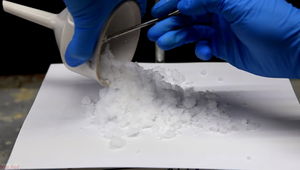Ammonium formate
 Wet ammonium formate
| |
| Names | |
|---|---|
| IUPAC name
Ammonium formate
| |
| Other names
Azanium formate
| |
| Identifiers | |
| Jmol-3D images | Image |
| |
| Properties | |
| CH5NO2 NH4HCOO | |
| Molar mass | 63.06 g/mol |
| Appearance | White hygroscopic solid |
| Odor | Slightly ammoniac |
| Density | 1.26 g/cm3 |
| Melting point | 116 °C (241 °F; 389 K) |
| Boiling point | 180 °C (356 °F; 453 K) (decomposes) |
| 102 g / 100 ml (0 °C) 142.7 g / 100 ml (20 °C) 202.4 g / 100 ml (40 °C) 516 g / 100 ml (80 °C) | |
| Solubility | Soluble in liquid ammonia, diethyl ether, ethanol, methanol Insoluble in acetone, benzene, chloroform, toluene |
| Thermochemistry | |
| Std enthalpy of
formation (ΔfH |
−556.18 kJ/mol |
| Hazards | |
| Safety data sheet | ScienceLab |
| Lethal dose or concentration (LD, LC): | |
| LD50 (Median dose)
|
410 mg/kg (mice, intravenous) |
| Related compounds | |
| Related compounds
|
Ammonium acetate |
| Except where otherwise noted, data are given for materials in their standard state (at 25 °C [77 °F], 100 kPa). | |
| Infobox references | |
Ammonium formate is an organic chemical compound, an ammonium salt of formic acid. It is a colorless, hygroscopic solid, with the chemical formula NH4HCOO.
Contents
Properties
Chemical
Heating ammonium formate will cause it to convert it into formamide:
- NH4HCO2 → HCONH2 + H2O
Further heating the formamide will cause it to decompose into carbon monoxide and ammonia, while at higher temperatures and in the presence of an acid catalyst it will yield hydrogen cyanide:
- HC(O)NH2 → CO + NH3
- HC(O)NH2 → HCN + H2O
Ammonium formate can be used in the reductive amination of aldehydes and ketones, process known as Leuckart reaction.
One example is the conversion of acetone to isopropylamine:
- HCOONH4 + (CH3)2CO → (CH3)2HC-NH2 + H2O + CO2
Physical
Ammonium formate is a hygroscopic white crystalline solid, soluble in water.
If wet ammonium formate is left to dry in a desiccator over the course of weeks or months, tiny white crystals of dry ammonium formate shaped like snowflake arms or fern leaves will form on the edge of the flask.
Availability
Ammonium formate is sold by big chemical suppliers, while smaller suppliers rarely have it in their stock.
Preparation
Ammonium formate can be made by bubbling ammonia through formic acid, though this requires lots of ammonia. An ammonium salt, such as ammonium bicarbonate can be used instead. Cooling the solution will cause the salt to precipitate. Excess water can be evaporated by carefully heating the solution, at below 115 °C, to prevent it from melting/decomposing. Filter the resulting precipitate and leave it to dry, either in open air or in a desiccator. Heating will not dry ammonium formate, instead it will decompose, resulting in a yellow syrup containing water, formamide and ammonium formate.[1]
Since it's hygroscopic, it's best to keep it in a desiccator until you need it.
Projects
- Make formamide
- Make isopropylamine and other amines from ketones (Leuckart reaction)
Handling
Safety
Ammonium formate may release formic acid vapors and protection should be worn when handling the compound.
Storage
Ammonium formate should be kept in closed bottles, away from moisture. Can be stored in a desiccator. Ammonia may be added to limit hydrolysis.
Disposal
Mixing it with an alkali will neutralize it, though it's best to do this outside, as the reaction gives off ammonia.
References
Relevant Sciencemadness threads
- Chemical pages without CAS Registry Number
- Articles without EBI source
- Chemical pages without ChemSpiderID
- Chemical pages without DrugBank identifier
- Articles without KEGG source
- Articles without InChI source
- Articles without UNII source
- Articles containing unverified chemical infoboxes
- Chemical compounds
- Organic compounds
- Ammonium compounds
- Buffering agents
- Easily prepared chemicals
- Formates
- DEA SS List